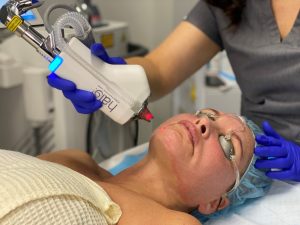What Is Laser Season?
Posted February 18, 2022 in MedSpa Treatments
In the aesthetics industry, laser season is a real thing. We consider fall and winter the seasons for laser procedures because the laser recovery process will feel more comfortable. Exposure to intense summer temperatures and extended UV rays are less likely because people are back from vacations and pool time. Laser treatments are safest and most effective when a patient has been free from sun exposure for at least 3 weeks and plans to avoid being in the direct sun for a few weeks after treatment. Too much sun exposure prior to a laser treatment has a higher risk of burning and blistering the skin. Freshly lasered skin that is exposed to the sun may lead to post inflammatory hyperpigmentation.
There are many things we have learned to do to prevent common skin concerns such as fine lines, wrinkles, sagging skin and skin cancer. We wear sunscreen, hats, and sunglasses; however, that is not always enough. Our skin type, genetics and lifestyle all contribute to how our skin handles the sun’s intense rays. UVA exposure darkens the pigment of skin and causes premature aging. Laser treatments are used to treat sun damaged skin beyond what creams can do, resulting in a fresh, new youthful glow.

Halo laser treatment
What are my laser treatment options?
There are two different laser treatment types to address sun damaged skin: ablative and non-ablative treatments.
Non-ablative laser treatments do not create wounds on the skin’s surface. Sciton BBL is a light based, non-ablative procedure that has minimal to no down time and can address skin concerns such as rosacea, sun damage spots and broken capillaries, while also stimulating collagen in the deeper dermis. Most patients can return to their normal activities and skin care regimen immediately after a non-ablative treatment.
An ablative laser treatment wounds the top layer of skin to create a healing and repair response. Our skin sheds the damaged surface and in turn creates new skin cells resulting in brighter, more even toned skin with a reduction in fines lines and wrinkles. The period for healing from a Halo or ProFractional ablative treatment is typically 4-7 days from the day of the procedure. Older common methods of ablative procedures normally have a 7–10-day social downtime associated with recovery, and 3 to 4 weeks of having pink, new skin.
At Wake Plastic Surgery, we have one of the best lasers in the industry. The Sciton Joule offers both the Halo and ProFractional treatments to target sun damage, texture issues and scar pigmentation with shorter, less painful downtimes. Halo is the world’s first and only hybrid fractional laser which means it delivers ablative and non-ablative laser wavelengths.
Our highly trained and experienced medical aestheticians, Kristi, or Carla, offer a thorough personal consultation to determine the best treatment plan for addressing your skin concerns. Please call us if you have any questions or contact us to schedule a consultation by clicking here!
